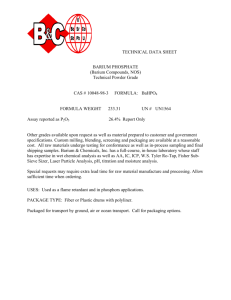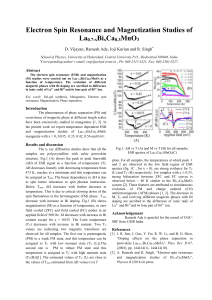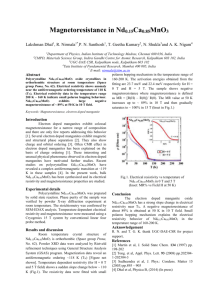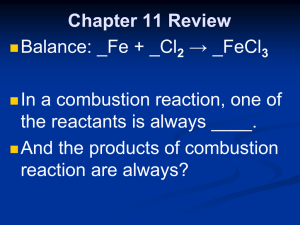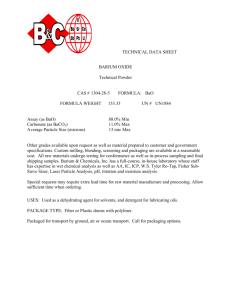Synthesis, structural and transport properties of nanocrystalline La Ba MnO
advertisement
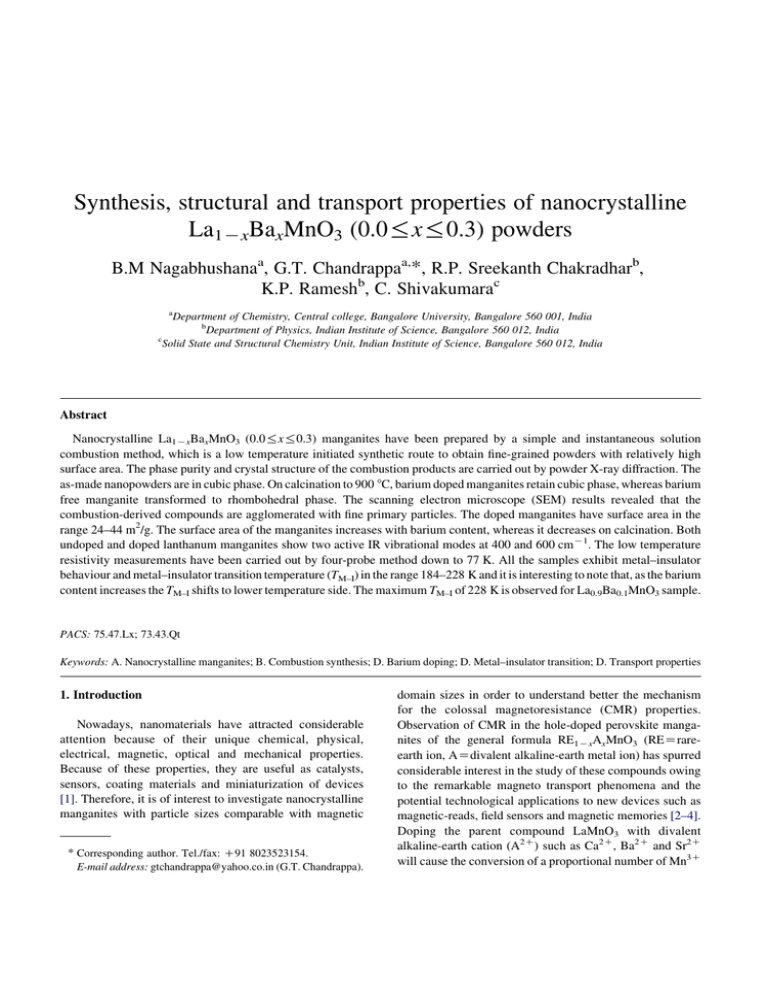
Synthesis, structural and transport properties of nanocrystalline La1KxBaxMnO3 (0.0%x%0.3) powders B.M Nagabhushanaa, G.T. Chandrappaa,*, R.P. Sreekanth Chakradharb, K.P. Rameshb, C. Shivakumarac a Department of Chemistry, Central college, Bangalore University, Bangalore 560 001, India b Department of Physics, Indian Institute of Science, Bangalore 560 012, India c Solid State and Structural Chemistry Unit, Indian Institute of Science, Bangalore 560 012, India Abstract Nanocrystalline La1KxBaxMnO3 (0.0%x%0.3) manganites have been prepared by a simple and instantaneous solution combustion method, which is a low temperature initiated synthetic route to obtain fine-grained powders with relatively high surface area. The phase purity and crystal structure of the combustion products are carried out by powder X-ray diffraction. The as-made nanopowders are in cubic phase. On calcination to 900 8C, barium doped manganites retain cubic phase, whereas barium free manganite transformed to rhombohedral phase. The scanning electron microscope (SEM) results revealed that the combustion-derived compounds are agglomerated with fine primary particles. The doped manganites have surface area in the range 24–44 m2/g. The surface area of the manganites increases with barium content, whereas it decreases on calcination. Both undoped and doped lanthanum manganites show two active IR vibrational modes at 400 and 600 cmK1. The low temperature resistivity measurements have been carried out by four-probe method down to 77 K. All the samples exhibit metal–insulator behaviour and metal–insulator transition temperature (TM–I) in the range 184–228 K and it is interesting to note that, as the barium content increases the TM–I shifts to lower temperature side. The maximum TM–I of 228 K is observed for La0.9Ba0.1MnO3 sample. PACS: 75.47.Lx; 73.43.Qt Keywords: A. Nanocrystalline manganites; B. Combustion synthesis; D. Barium doping; D. Metal–insulator transition; D. Transport properties 1. Introduction Nowadays, nanomaterials have attracted considerable attention because of their unique chemical, physical, electrical, magnetic, optical and mechanical properties. Because of these properties, they are useful as catalysts, sensors, coating materials and miniaturization of devices [1]. Therefore, it is of interest to investigate nanocrystalline manganites with particle sizes comparable with magnetic * Corresponding author. Tel./fax: C91 8023523154. E-mail address: gtchandrappa@yahoo.co.in (G.T. Chandrappa). domain sizes in order to understand better the mechanism for the colossal magnetoresistance (CMR) properties. Observation of CMR in the hole-doped perovskite manganites of the general formula RE1KxAxMnO3 (REZrareearth ion, AZdivalent alkaline-earth metal ion) has spurred considerable interest in the study of these compounds owing to the remarkable magneto transport phenomena and the potential technological applications to new devices such as magnetic-reads, field sensors and magnetic memories [2–4]. Doping the parent compound LaMnO3 with divalent alkaline-earth cation (A2C) such as Ca2C, Ba2C and Sr2C will cause the conversion of a proportional number of Mn3C to Mn4C. The mixed valencies of Mn ions play a major role in double exchange (DE) mechanism [5–7]. It is believed that the DE interaction between Mn4C and Mn3C ion pairs is responsible for the metallic character and ferromagnetic (FM) properties in these manganese oxides. There are many techniques for the preparation of perovskite based rare earth manganites, which include solid-state reaction [8], sol–gel [9], nitrate citrate gelcombustion [10], co-precipitation [11], acrylamide polymerization [12], hydrothermal [13], combustion [14] and microwave techniques [15]. A majority of work available on the synthesis of barium doped lanthanum manganites is generally based on high temperature ceramic method. In the present work, we describe a simple and novel method of synthesizing nanocrystalline barium substituted lanthanum manganites by a low temperature initiated solution combustion route using oxalyl dihydrazide (ODH) as a fuel and the corresponding metal nitrates as oxidizers. Instantaneous combustion synthesis is an important powder processing technique generally used to prepare oxide ceramics [16]. It involves several advantages like fast heating rates, short reaction time (w5 min), besides producing foamy, homogeneous and high surface area nanocrystalline products. It has also the advantage of doping desired amounts of dopant ions in solution medium and ‘low processing temperature’ leading to uniform crystallite size at superfine dimensions. High purity and homogeneity can be achieved at temperature as low as 300 8C as against 1470 8C needed to synthesize these materials via ceramic route [17]. The combustion products are characterized by XRD, EDS, SEM, surface area and FTIR. The zero field low temperature resistivity measurements down to 77 K were carried out by four-probe method on sintered pellette samples. 2. Experimental 2.1. Chemicals Analar grade lanthanum nitrate (La(NO3)3$4H2O), barium nitrate (Ba(NO3)2$4H2O) and manganese nitrate (Mn(NO3)2$4H2O) were used as oxidizers and oxalyl dihydrazide, C2H6N4O2(ODH) as a fuel. ODH was prepared in our laboratory by the reaction of diethyl oxalate with hydrazine hydrate [18]. The detailed calculation of stoichiometry has been reported elsewhere [19]. 2.2. Synthesis of La1KxBaxMnO3 (0.0%x%0.3) manganites The aqueous solution containing metal nitrates and fuel are taken in a petri dish of approximately 300 ml capacity and excess water is allowed to evaporate by heating on a hot plate until wet powder is left out. Then the petri dish is introduced into a muffle furnace maintained at 300 8C. Initially, the wet powder undergoes dehydration followed by decomposition with large amount of gases (oxides of nitrogen and carbon). The mixture ignites and catches fire to give a voluminous combustion product. The as-formed powders are free from carbon residue. Assuming complete combustion, the general equation for the formation of samples can be proposed as follows ð1KxÞLaðNO3 Þ3 ðaqÞ C xBaðNO3 Þ2 ðaqÞ C MnðNO3 Þ2 ðaqÞ C C2 H6 N4 O2 ðaqÞ/ La1Kx Bax MnO3 ðSÞ C CO2 ðgÞ C H2 OðgÞ C N2 ðgÞ The phase purity and crystal structure were examined by Scintag X-ray diffractometer using Cu Ka radiation with a nickel filter. The average crystallite sizes were determined by Debye–Scherrer’s formula. The morphology of the powder was examined using JEOL (JSM-840 A) scanning electron microscope (SEM). The specific surface area of the powder samples was determined by Quanta Chrome Corporation, NOVA 1000 Gas Sorption Analyzer. FTIR spectra of the as-formed and calcined samples were performed with Perkin–Elmer–FTIR spectrometer, (spectrum 1000). The electrical resistivity measurements were carried out on sintered pellets at 900 8C for 6 h in air, using Dc four-probe method in the range 77–300 K. 3. Results and discussion 3.1. Powder X-ray diffraction Figs. 1 and 2 show the powder X-ray diffraction patterns of as-formed and calcined (900 8C, 6 h) La1KxBaxMnO3 (0.0%x%0.3) samples, respectively. As-formed La1KxBaxMnO3 as well as calcined La1KxBaxMnO3 compounds show crystalline cubic phase. The XRD patterns of the as-formed samples with xZ0 and 0.1 (Fig. 1(a) and (b)) show complete crystalline, impurity free phase with cubic symmetry, whereas for xZ0.2 and 0.3 (Fig. 1(c) and (d)) show small impurity peak at 2qz248 correspond to BaCO3 [JCPDF No. 45-1471]. The formation of BaCO3 phase might be due to the result of the reaction between BaO and CO2 evolved during combustion process. On calcination at 900 8C for 6 h, BaCO3 formed during combustion gets decomposed and hence all calcined barium doped manganites show cubic phase free from BaCO3 impurity (Fig. 2(b)–(d)), whereas parent lanthanum manganites on calcination (900 8C, 6 h) transformed to rhombohedral phase. The strong oxidizing atmosphere, which exists during combustion reaction, leads to excess of Mn4C (more than 34%) formation in these compounds and stabilizes cubic phase [20]. The broadness of XRD peaks indicates the nanocrystalline nature of the combustion-derived products. Crystallite sizes of the asmade and calcined powders were calculated from the broadening of the X-ray diffraction peaks using the Scherrer’s formula [21], SZ Kl=b cos q, where K is Fig. 1. PXRD patterns of as-formed La1KxBaxMnO3 (0.0%x%0.3) (*BaCO3 impurity peaks): (a) xZ0.0; (b) xZ0.1; (c) xZ0.2; and (d) xZ0.3. constant, l is the wave length of Cu Ka radiation (1.541 Å) and b is the full width at half maxima (FWHM) of XRD peaks. In the present work, the crystallite sizes of the doped lanthanum manganites are in the range 33–45 nm. As the barium content increases in La1KxBaxMnO3, the diffraction peaks slightly shift to lower 2q values, indicating that the lattice-parameters increase with the increase of barium doping level, which may be caused by larger ionic size of Ba2C(1.61 Å) ion in comparison with La3C(1.36 Å) ion. This shift also confirms the accommodation of Ba2C ion into the lattice structure. The structure of the calcined (900 8C, 6 h) compounds was refined by Rietveld technique [22] using Fullprof suite program. Doped compounds are refined in cubic structure with Pm3m space group, whereas undoped calcined LaMnO3 sample refined (hexagonal setting) in rhombohedral symmetry with R-3c space group. The composition, refined, structural, lattice parameters and R-factors are summarized in Table 1. 3.2. Scanning electron microscope The surface morphology of La1Kx Bax MnO3 (0.0%x%0.3) series was investigated by SEM. All combustion-derived samples are foamy products with large agglomerates of very fine particles. The foamy nature of combustion-derived samples can be attributed to large amount of gases evolved during combustion reaction. Fig. 2. PXRD patterns of calcined (900 8C, 6 h) La1KxBaxMnO3 (0.0%x%0.3) samples: (a) xZ0.0; (b) xZ0.1; (c) xZ0.2; and (d) xZ0.3. The inset shows the shift in (110) peak with x. Fig. 3(a) shows SEM micrograph of as-formed LaMnO3 sample and the size of the agglomerated particles are in the range 0.5–4.0 mm. Fig. 3(b) and (c) show micro photographs of as-formed and calcined La0.7Ba0.3MnO3 (900 8C, 6 h) samples, respectively. It is observed that in doped manganites, the size of the primary particles in agglomerates is smaller compared to undoped manganites. The reduction in particle size with barium doping leads to increase in surface area and this is confirmed by surface area measurements. However, in calcined La0.7Ba0.3MnO3 manganites, the particle size increases that leads to decrease in surface area of the sample. 3.3. Determination of Mn4C concentration The Mn4C content is a crucial factor in determining the magnetic and transport properties of manganites [8,23,24]. The electron hopping between Mn3C and Mn4C is responsible for the relatively low resistivity as well as the ferromagnetism. In the present study, the Mn4C content in as-formed and calcined La1KxBaxMnO3 (0.0%x%0.3) manganites is estimated from the iodometric titration [25]. It is found that the Mn4C concentration in as-formed samples is 34, 36, 40 and 45% for xZ0.0, 0.1, 0.2 and 0.3, respectively. Whereas, in calcined samples it reduces to 32, 34, 37 and 40%, the strong oxidizing atmosphere that exists during combustion reaction also leads to excess of Mn4C Table 1 Composition, lattice parameters, cell volume and R-factors of nanocrystalline La1KxBaxMnO3 samples (900 8C, 6 h) Compounds LaMnO3 La0.9Ba0.1MnO3 La0.8Ba0.2MnO3 La0.7Ba0.3MnO3 System Space group Lattice parameter (Å) Rhombohedral R-3c aZ5.505(4) cZ13.301(5) aZ60.68 (2) 58.184 Cubic Pm3m aZ3.891(4) Cubic Pm3m aZ3.898(4) Cubic Pm3m aZ3.91(5) 58.924 59.244 59.325 0.000 0.000 0.250 0.000 0.000 0.000 0.000 0.000 0.000 0.000 0.000 0.000 0.000 0.000 0.000 0.500 0.500 0.500 0.500 0.500 0.500 0.500 0.500 0.500 0.458(24) 0.000 0.250 2.67 3.48 2.71 4.03 0.500 0.500 0.500 4.05 5.49 4.44 3.66 0.500 0.500 0.500 3.45 4.61 3.58 2.64 0.500 0.500 0.500 3.86 4.94 5.60 3.99 Unit cell volume (Å)3 La/Ba(1a) x y z Mn(1b) x y z O1(1c) x y z RP RWP RBrag RF content in these compounds, compared to the samples prepared by high temperature routes. 3.4. Measurement of surface area The surface areas of the undoped and doped manganites have been determined by Braunauer, Emmet and Teller (BET) method using nitrogen as adsorbent gas [26]. It is interesting to observe that the surface area of La1Kx BaxMnO3 (0.1%x%0.3) increases with barium doping, whereas it decreases on calcination. In calcined (900 8C, 6 h) barium doped as-formed samples, the surface of 12.5, 20.2, 26.0 and 37.8 m2/g have been observed for xZ0.0, 0.1, 0.2 and 0.3, respectively. This may be due to on increase in barium content, the fire retention time decreases and this leads to the formation of products with smaller grain size. As gaseous products liberated during combustion, the agglomerates disintegrate and more heat is carried away from the system, thereby hindering the particle growth, leads to high surface area [27,28]. The surface area of LaMnO3 and La0.7Ba0.3MnO3 manganites decreases with calcination as 24.0, 19.5, 18.3, 12.5, 0.5 and 58.5, 53.2, 39.6, 37.8, 2.2 m2/g, respectively, at as-formed, 400, 650, 900 and 1200 8C. The decrease in surface area with calcination is due to an increase in particle size. 3.5. Fourier transform infrared spectroscopy FTIR spectra of a series of as-formed and that of calcined (900 8C, 6 h) La1KxBaxMnO3 (0.1%x%0.3) samples show two characteristic IR bands. The band around 600 cmK1 corresponds to the stretching mode ns, which involves the internal motion of a change in length of the Mn–O bond; the band around 400 cmK1 corresponds to the bending mode nb, which is sensitive to a change in the Mn–O–Mn bond angle [29,30]. As formed samples show IR band at 1450cmK1 assignable to BaCO3 [31] impurity and on calcination (at 900 8C for 6 h) this band disappears. The formation of BaCO3 is also evidenced by PXRD. 3.6. Low temperature resistivity measurements The electrical transport behaviour is experimentally studied by measuring resistivity as a function of temperature by means of standard four-probe method without an applied magnetic field. The variation of zero field resistivity of La1Kx BaxMnO3 (0.0%x%0.3) pellets (sintered at 900 8C for 6 h) as a function of temperature down to 77 K is shown in Fig. 4. We observed that the samples studied in the present work show different resistivity behavior from that of single crystalline [32] material and also the samples prepared by ceramic route [33]. Hwang et al. [32] compared the magnetotransport property in polycrystalline samples with that in the single crystal. It was found that the polycrystalline compounds exhibited high resistivity values, which are far above those of single crystal, and a sharp drop of resistance in the low magnetic field. According to the experimental results, they attributed this to spin-polarized tunneling through an insulating grain boundary. The DE mechanism links the electronic transport to the magnetic Fig. 4. Low temperature electrical resistivity of La1KxBaxMnO3 (0.0%x%0.3) samples. Fig. 3. SEM micrographs of (a) as-formed LaMnO3; (b) as-formed La0.7Ba0.3MnO3; and (c) calcined La0.7Ba0.3MnO3 (900 8C, 6 h). transition and describes the hopping of electrons in eg orbitals between neighbouring Mn3C and Mn4C sites with strong on-site Hund’s coupling through an O2K ion. The electrons in these materials are able to move easily (enhancement in the ferromagnetic state) when the spins of the ions (Mn3C and Mn4C) are parallel and cannot move if they are antiparallel [34]. Doped lanthanum manganites with bigger grain size exhibit sharp metal–insulator transition. However, combustion derived samples show a broad transition due to nanocrystalline nature of the powders [35,36]. Studies on La1Kx Ba x MnO 3, in the present work show distinct resistivity maxima due to metal–insulator transition and exhibit TM–I in the range 184–228 K. It is interesting to note that, as the barium content increases the TM–I shifts to lower temperature side. The maximum TM–I of 228 K is observed for La0.9Ba0.1MnO3 sample. The observed TM–I values for this sample found to be lower compared to the samples prepared via ceramic route [37] might be due to grain boundary effect. The effect of grain size on magnetic, transport and structural properties of manganites have been studied by several investigators [38–40] which are attributed that the particles size, the doping level in lanthanum site, oxygen content and grain boundary effect play an important role in magnetic and electronic properties of these oxides. However, many controversial reports have also been reported in the literature pertaining to the effect of grain size on the magnetic properties of polycrystalline manganites. For instance Zhang et al. [39] studied the effect of grain size in La0.85Sr 0.15MnO 3 and found that the magnetization and Curie temperature (TC) decreases with increase in grain size. Sanchez et al. [38] have reported a contrary results, i.e. the decrease of TC of La.67Ca0.33MnO3 with decreasing grain size. In the present study, we observed that the resistivity slightly increases with barium content up to xZ0.2 and thereafter decreases. La0.7Ba0.3MnO3 sample exhibit low resistivity at room temperature as well as at TM–I because, this compound consists of high concentration of Mn4C (40%). In presence of high concentration of Mn4C, there is formation of the maximum number of ferromagnetic clusters consist of Mn3C and Mn4C within a grain. The hopping of electron from Mn3C to Mn4C via oxygen is rapid and giving rise to relatively low resistivity for La0.7Ba0.3MnO3 [41]. 4. Conclusions Nanocrystalline manganites of composition La1KxBaxMnO3 (0.0%x%0.3) have been synthesized by solution combustion route using corresponding metal nitrates as oxidizers and ODH as fuel. The time taken for the preparation is only few minutes (w5 min) and the synthesis temperature employed is lower than those currently used in conventional routes. This method also enables the formation of homogeneous and high surface area nanocrystalline powders of manganites. The as-formed manganites show crystalline cubic phase with impurity peak corresponds to BaCO3. The stabilization of cubic phases in doped lanthanum manganites is due to substitution of Ba2C in La3C sites, resulting in higher Mn4C content. The resistivity results showed that the barium doping level has a direct effect on the TM–I and resistance of the samples. With increase in the barium doping level, TM–I shifts to a lower temperature, which is encouraging. It is of interest to investigate CMR property of combustion derived nanocrystalline samples indeed, nanocrystalline manganites have a higher magnitude of the low field magnetoresistance as compared to ceramic samples and hence, further investigation on magnetic behavior and magnetoresistance studies are in progress. Acknowledgements G.T. Chandrappa gratefully acknowledges the financial support extended by DST (Government of India), New Delhi under the scheme Nanomaterials Science and Technology Initiative to carry out this work. References [1] [2] [3] [4] [5] [6] [7] [8] [9] [10] [11] [12] [13] [14] [15] [16] [17] [18] [19] [20] [21] [22] [23] [24] [25] [26] [27] [28] [29] [30] [31] [32] [33] [34] [35] [36] [37] [38] [39] [40] [41] A.P. Alivisatos Science 271 1996 933 J.Z. Sun, et al., Appl. Phys. Lett. 69 (1996) 3266. S. Jin, et al., Science 264 (1994) 413. H.Y. Hwang, et al., Phys. Rev. Lett. 77 (1996) 2041. C. Zener, Phys. Rev. B 82 (1951) 403. P.W. Anderson, H. Hasegawa, Phys. Rev. 100 (1955) 675. P.G. De Gennes, Phys. Rev. 118 (1960) 141. G.H. Jonker, J.H. Van Santen, Physica 16 (1950) 337. E.L. Hueso, et al., J. Appl. Phys. 86 (1999) 3881. D.G. Lamas, et al., J. Magn. Magn. Mater. 241 (2002) 207. E. Vladimirova, et al., J. Mater. Sci. 36 (2001) 1481. G. Dezanneau, et al., Solid State Commun. 121 (2002) 133. J. Liu, et al., Mater. Res. Bull. 38 (2003) 817. S.T. Aruna, et al., J. Mater. Chem. 7 (1997) 2499. R.K. Sahu, et al., J. Mater. Sci. 36 (2001) 4099. S. Ekambaram, J. Alloys Compd. 390 (2005) L4. M. Verelst, et al., J. Solid State Chem. 104 (1993) 74. G. Gran, Anal. Chim. Acta 14 (1956) 150. G.T. Chandrappa, et al., J. Mater. Synth. Proc. 7 (1999) 273. G.H. Jonker, J. Phys. Chem. Solids 9 (1959) 165. H. Klug, L. Alexander, X-ray Diffraction Procedures, Wiley, New York, 1962. pp. 491. D.B. Wiles, R.A. Young, J. Appl. Crystallogr. 14 (1981) 149. E.O. Wollan, W.C. Koehler, Phys. Rev. 100 (1955) 545. R. Mahendiran, et al., Pramana 44 (1995) L393. R.N. Singh, et al., J. Solid State Chem. 132 (1998) 19. S. Brunauer, et al., J. Am. Chem. Soc. 66 (1938) 309. J. McKittrick, et al., Displays 19 (1999) 169. C.-C. Hwang, T.-Y. Wu, Mater. Sci. Eng. B 111 (2004) 197. F. Gao, et al., J. Alloys Compd. 347 (2002) 314. A. Arulraj, C.N.R. Rao, J. Solid State Chem. 145 (1999) 557. Z. Min-Guang, et al., J. Phys.: C 20 (1987) L917. H.Y. Hwang, et al., Phys. Rev. Lett. 77 (1996) 2041. H.L. Ju, et al., Phys. Rev. B 9 (1995) 6143. C. Zener, Phys. Rev. 81 (1951) 440. R. Mahesh, et al., Appl. Phys. Lett. 68 (1996) 2291. S.L. Yuan, et al., Solid State Commun. 121 (2002) 291. S.V. Trukhanov, J. Mater. Chem. 13 (2003) 347. R.D. Sanchez, et al., Appl. Phys. Lett. 68 (1996) 134. N. Zhang, et al., J. Phys.: C Matter 9 (1997) 4281. N. Zhang, et al., Phys. Rev. B 56 (1997) 8138. R. Mahendiran, et al., Solid State Commun. 99 (1996) 149.
